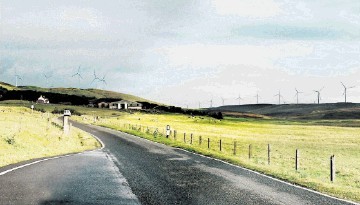
The Scottish Government has backed plans for construction of the country’s largest community windfarm in Shetland.
The 103-turbine Viking scheme is expected to pump £20million a year into a charitable trust and create more than 170 temporary and permanent jobs.
Politicians and the local authority hailed the move last night as a massive boost to the islands and the renewable energy sector.
However, anti-windfarm campaigners and conservation groups claimed its impact on a world-renowned landscape would be “unimaginable” and said the decision by SNP ministers to support the project was “worrying”. The Viking scheme has been scaled down from the 150 turbines originally proposed but is still the third-largest windfarm in Scotland.
The developers claim the £566million project will have the potential to power about 175,000 homes – the islands have a population of 22,000 – and generate an annual income of £30million.
Two-thirds of the cash will go to the Shetland Charitable Trust.
About 140 jobs would be created during the five-year construction phase, with 34 people employed when it is completed.
The developers say the windfarm will also justify construction of an interconnector cable to export electricity to the mainland, and open up further renewable energy development.
In February, more than 300 people marched through the centre of Lerwick in protest at the plans and 2,700 lodged objections to the windfarm, compared with 1,100 who backed it.
Objectors claimed it would be the “largest industrial development” in the history of the islands. They believe it will damage peatlands, which they say are valuable in the war against climate change, and could threaten vulnerable bird species such as the whimbrel and red-throated divers.
Bill Manson, chairman of the Viking Energy Partnership, said an enormous amount of consultation had been carried out to create a project designed with Shetland’s special environment in mind.
“This is good news for Shetland, good news for Scotland and good news for the fight against climate change,” he said.
“The associated grid connection will unlock future renewable projects, including marine energy, and help us generate a whole new sustainable industry.”
He added: “At the same time we appreciate that not everybody will be happy about this decision and we want to reassure those who opposed the application that we will continue to endeavour to minimise or mitigate any impacts.”
The original 150-turbines scheme on moorland in the central mainland of Shetland was reduced to 127, but ministers have withheld consent for 24 in the northern Delting Parish sections that would have affected instruments at Scatsta Airport.
Energy Minister Fergus Ewing said yesterday the project would “bring enormous benefits to the people of Shetland”.
He added: “The development will create jobs and bring income, and makes the case for an interconnector to connect Shetland for the first time to the national grid.
“The development includes an extensive habitat management plan covering around 12,800 acres, which will restore peatland and offer benefits to a whole range of species and habitats.”
Douglas Irvine, Shetland Islands Council’s executive manager for economic development, said: “We are delighted with the announcement today by the energy minister, which will unlock in time a renewable energy industry in Shetland.”
Viking Energy is an equal partnership between a company set up to represent the interests of the Shetland community and power giant Scottish and Southern Energy.
Recommended for you
